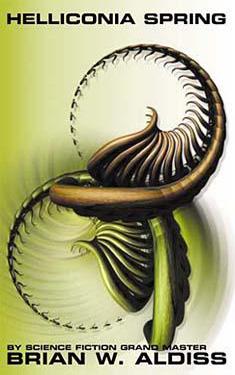Outside the Norm: Nnedi Okorafor’s Zahrah the Windseeker and The Shadow Speaker
Rhonda Knight is an Associate Professor of English at Coker College in Hartsville, SC. She teaches Medieval and Renaissance literature as well as composition courses. When she looked over last year’s reading list, she was shocked to see that only 17% of the authors she read were women. This blog will record her attempts to read authors that are generally considered out of the science fiction norm: women, persons of color, and non-U.S. and non-U.K. authors.
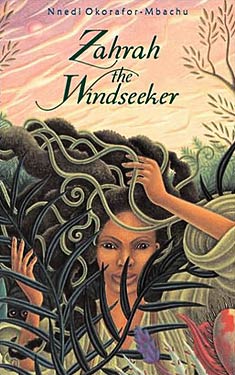 When I started thinking about authors I would read for this series, Nnedi Okorafor was at the top of my list. I started with two of her young adult novels, Zahrah the Windseeker and The Shadow Speaker because they were available in my college library. Both of these novels feature female protagonists who are about fourteen years old. Each girl has a special magical power and learns to use her power when she embarks upon a quest. As such, these are coming-of-age narratives that show how the girl, who is different, who is teased for being different, comes into her own and learns of her own strength and self-worth. This seems to me to be what many YA novels do; however, I did not really read YA novels when I was a “YA” (except that I had a great obsession with The Hardy Boys mysteries), so I am far from an expert.
When I started thinking about authors I would read for this series, Nnedi Okorafor was at the top of my list. I started with two of her young adult novels, Zahrah the Windseeker and The Shadow Speaker because they were available in my college library. Both of these novels feature female protagonists who are about fourteen years old. Each girl has a special magical power and learns to use her power when she embarks upon a quest. As such, these are coming-of-age narratives that show how the girl, who is different, who is teased for being different, comes into her own and learns of her own strength and self-worth. This seems to me to be what many YA novels do; however, I did not really read YA novels when I was a “YA” (except that I had a great obsession with The Hardy Boys mysteries), so I am far from an expert.
What amazes me is the variety of plots that YA authors devise to illustrate this common theme. As proof of this, the young heroes Zahrah Tsami and Ejii Ugabe (who is the protagonist of The Shadow Speaker) demonstrate different strengths and weaknesses as they experiment with their powers; the goals of their quests are nothing alike; and the plots are not formulaic and are paced quite differently from each other. Both Ejii and Zahrah are metahumans (or in the older lingo, dada). Ejii’s skills are apparent from the beginning of the novel, while Zahrah learns what her talents are during the course of her narrative. Zahrah is born with dadalocks, which seem to be dreadlocks that have vines incorporated in them. Here’s what Zahrah says about being born dada:
“To many, to be dada meant you were born with strange powers. That you could walk into a room and a mysterious wind would knock things over or clocks would automatically stop; that your mere presence would cause flowers to grow underneath the soil instead of above. That you caused things to rebel or that you would grow up to be rebellious yourself! And what made things even worse was that I was a girl, and only boys and men were supposed to be rebellious. Girls were supposed to be soft, quiet, and pleasant.” (Zahrah the Windseeker viii).
One great thing that these books have in common is a complex magical world that engenders these metahumans, which is what I want to discuss in this blog. According to Okorafor’s website, Who Fears Death and her other YA novel, Akata Witch are set in the same world.
Okorafor’s literary setting contains several parallel worlds, Earth, Lif, Ginen, Ngiza, and Agonia (The Shadow Speaker 301). Zahrah the Windseeker is set in the village of Kirki in the Ooni Kingdom, which is in Ginen. In this novel, few characters know that there are parallel worlds. For Zahrah and her friend, Dari, Earth is only a myth, until they meet Nsibidi who claims her mother is from Earth. The Shadow Speaker occurs later in the timeline because, in Ejii’s Earth, people are able to move between parallel worlds. Ejii’s quest requires her to leave her Nigerien village of Kwàmfà and to travel to the Ooni Kingdom in Ginen. The shadows who whisper to her have told her that only her presence at the multi-world meeting of the Golden Dawn can stop the other parallel worlds from declaring war against Earth.
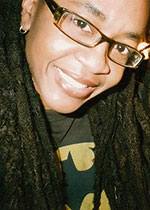 The year of Ejii’s adventure is 2070. She lives after the Great Change, a series of events that engendered both magic and mutants on Earth. The Great Change is the “result of nuclear and Peace Bombs being dropped all over the earth. The Peace Bomb was the tool of an enviro-militant group called the Grand Bois, headed by a Haitian man named Dieuri [who], himself, was responsible for crossing science and magic and creating the Peace Bomb, a weapon consisting of airborne biological agents meant to counteract the effects of nuclear missiles” (55). Besides shadow speakers, who can listen to the shadows, interpret the thoughts and feelings of other sentient beings, and communicate with some of animals and non-humans, there are windseekers, like Zahrah, who can fly. Other metahumans that receive less attention in Okorafor’s books are shape-shifters, faders, firemolders, rainmakers and metalseekers. Many animals in her worlds can speak, such as Onion, Ejii’s camel:
The year of Ejii’s adventure is 2070. She lives after the Great Change, a series of events that engendered both magic and mutants on Earth. The Great Change is the “result of nuclear and Peace Bombs being dropped all over the earth. The Peace Bomb was the tool of an enviro-militant group called the Grand Bois, headed by a Haitian man named Dieuri [who], himself, was responsible for crossing science and magic and creating the Peace Bomb, a weapon consisting of airborne biological agents meant to counteract the effects of nuclear missiles” (55). Besides shadow speakers, who can listen to the shadows, interpret the thoughts and feelings of other sentient beings, and communicate with some of animals and non-humans, there are windseekers, like Zahrah, who can fly. Other metahumans that receive less attention in Okorafor’s books are shape-shifters, faders, firemolders, rainmakers and metalseekers. Many animals in her worlds can speak, such as Onion, Ejii’s camel:
“Onion was not like other camels. He was one of the few who could speak; one did not have to be a shadow speaker or any other type of metahuman to understand him. After the Great Change, Onion had realized that he had a bulge near the top of his long neck—a large, developed voice box. He’d been hearing human beings speak all his short life, for he was just a calf. It was not hard for him to do the same.” (The Shadow Speaker 74).
Like Ejii, Zahrah is able to converse with some other animals because of her dada powers.
In both cultures, metahumans are the minority and are feared by many people who say they bring bad luck or are evil creatures. The acceptance of metahumans seems more “progressive” in The Shadow Speaker, perhaps because the Great Change causes more of them. Ejii has two friends who are shadow speakers and together they train with an adult shadow speaker. On the other hand, Zahrah’s fear of her emerging abilities to levitate and fly and her desire to hide these abilities create the tragedy that brings about her quest into Ooni’s Forbidden Greeny Jungle.
Technology plays an important role in both stories. The way that Okorafor constructs technology in each parallel world is true to her overall portrayal of each. Ejii carries an e-legba, which seems to be like an iPad. The internet became immortal after the Great Change, continuing to work without either “power or maintenance” (The Shadow Speaker 93). Zahrah’s Ginen is a plant-based world. Zahrah has a floral computer:
“My father had given me the CPU seed when I was seven years old, and I had planted and taken care of it all by myself…. Its light green pod body was slightly yielding, and the large traceboard leaf fit on my lap like a part of my own body…. The computer would pull energy from my body heat, and I’d link a vine around my ear so that it could read my brain waves. It would grow in size and complexity, as I grew.” (Zahrah the Windseeker 37-38)
Many of the buildings are also engineered from plants. For example, the library in Zahrah’s village is a five-story building grown from a glassva, a transparent plant. At this library, Zahrah and her friend Dari checkout a digi-book, The Forbidden Greeny Jungle Field Guide, that accompanies her upon her quest. Okorafor has written a short story about a set of adventurers who contribute to this book and are looking for a rare wild CPU plant. (You can find “From the Lost Diary of Treefrog7” here.)
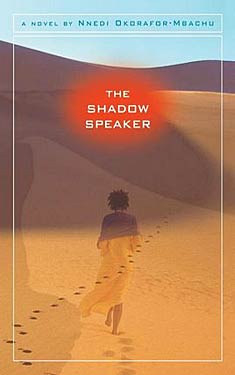 These novels are fun and exciting reads. As I read, I wished that I knew more about West African culture, mythology, and folklore. I felt as if I was missing out on some interesting nuances. For example, what am I missing when I read Ejii’s mother is New Tuareg and her father was Wodaabe? I learned a lot about these tribes from the links and was able to see how Okorafor used tribal traits of the Tuareg for characterization and plot. However, I feel that the stories of their stormy relationship is intended to be a metaphor of Niger, but I’m not well informed enough in Nigerien or West African history to understand.
These novels are fun and exciting reads. As I read, I wished that I knew more about West African culture, mythology, and folklore. I felt as if I was missing out on some interesting nuances. For example, what am I missing when I read Ejii’s mother is New Tuareg and her father was Wodaabe? I learned a lot about these tribes from the links and was able to see how Okorafor used tribal traits of the Tuareg for characterization and plot. However, I feel that the stories of their stormy relationship is intended to be a metaphor of Niger, but I’m not well informed enough in Nigerien or West African history to understand.
If I have any criticism of the books, it is that the conclusions leave you wanting more. I feel the ending of The Shadow Speaker was too abrupt. Ejji’s return home leaves open some questions about what happened in Kwàmfà while she was away. Zahrah the Windseeker has a much more extended ending, but Zahrah and Dari’s encounter with Nsibidi, a mysterious windseeker from Earth leaves the ending open. Both endings almost seem as if they are setting up sequels. However, Okorafor’s publishing history does not seem to indicate that she will revisit these characters even though she is revisiting this world in her more recent books, which I am now even more anxious to read. The conference that Ejii attends in Ginen gives us a glimpse of the peoples who live in the some of the other parallel worlds. I hope Okorafor decides to explore Lif, Ngiza, and Agonia as well.
I think some readers will not like Okorafor’s world as much as I do. She does not always explain things, and I’m sure if I looked I could find contradictions in the ways that the magic functions. However, I can very willingly suspend all sorts of disbelief when a setting is intriguing, the plot is good, and the characters are relatable. And they are.
GMRC Review: The Golden Apples of the Sun and Other Stories
 Editor’s Note: Rhonda Knight is a frequent contributor to WWEnd through her excellent blog series Automata 101 and her new series Outside the Norm. This is Rhonda’s third featured review for the Grand Master Reading Challenge.
Editor’s Note: Rhonda Knight is a frequent contributor to WWEnd through her excellent blog series Automata 101 and her new series Outside the Norm. This is Rhonda’s third featured review for the Grand Master Reading Challenge.
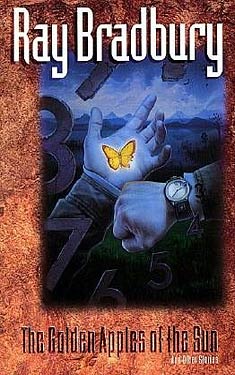 Ray Bradbury’s The Golden Apples of the Sun and Other Stories (1990) contains short stories from two of his previous works: one by the same name, published in 1953, and R is for Rocket, published in 1962. This reprint contains all of the stories from R is for Rocket and eighteen of the original twenty-two stories in the previous edition of Golden Apples. (The two collections had a couple of stories in both.)
Ray Bradbury’s The Golden Apples of the Sun and Other Stories (1990) contains short stories from two of his previous works: one by the same name, published in 1953, and R is for Rocket, published in 1962. This reprint contains all of the stories from R is for Rocket and eighteen of the original twenty-two stories in the previous edition of Golden Apples. (The two collections had a couple of stories in both.)
The stories from the original Golden Apples demonstrate the range of Bradbury’s writing. Many of them were originally published in mainstream publications, such as The New Yorker, Esquire, The Saturday Evening Post, and Colliers, and don’t demonstrate any science fiction or fantasy elements. They do, however, convey a sense of wonder and otherness. Because of this, many of them were recycled for HBO’s 1980s series, Ray Bradbury Theater. The strongest of these stories seem very current. “I See You Never” recounts the deportation of a Mexican immigrant who had overstayed his visa. “Sun and Shadow” is set in Mexico and explores a poor homeowner’s objection to his house being used as “local color” in the photos of an American fashion photographer. The protagonist in “The Murderer” reacts to modern technology in the same way that many of us wish we could. The murderer in “The Fruit in the Bottom of the Bowl” worries about leaving evidence behind.
The weaker stories do seem very dated. Many of them have ambiguous time settings, placed in either our past or an isolated “land that time forgot” setting. For this reason, I did not like “The Great Wide World Over There” and “Powerhouse.” I found “The Big Black and White Game” particularly puzzling. In telling about a baseball game between the white and black employees of a resort hotel, Bradbury displays that type of 1940s racism that doesn’t think it is racist. He clearly wants to denounce the overt racism of the white women in the story, but then he has the following passage, which I think is supposed to be complimentary:
"How easily the dark people had come running first, like those slow-motion deer and antelopes in those African moving pictures, like things in dreams. They came like beautiful brown, shiny animals that didn’t know that they were alive, but lived. And when they ran and put their easy, lazy, timeless legs out and followed with their big sprawling arms and loose fingers, and smiled blowing in the wind, their expressions did not say, ‘Look at me run, look at me run.’ No, not at all. Their faces dreamily said ‘Lord, but it’s sure nice to run…’"
Many reviews of “The Big Black and White Game” commend Bradbury for writing a story about racial tensions. I also learned that the story was chosen for Best American Short Stories in 1945. This story provides a good example of the way a dated story can jar a reader. I had trouble reconciling the author of Fahrenheit 451 to the author of this story. (This experience is making me add The Martian Chronicles to my list. I’m ashamed to say that I’ve never read it, but I’ve always seen it characterized as a book that exposes prejudice and racism.)
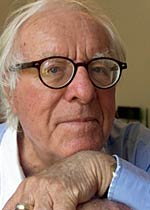 The new edition of Golden Apples does not indicate that the reader is moving from the earlier The Golden Apples of the Sun to R is for Rocket, but it does include Bradbury’s 1962 introduction to the latter book. He writes: “This is a book then by a boy who grew up in a small Illinois town and lived to see the Space Age arrive, as he hoped and dreamt it would.” This “book” is much more cohesive than the earlier section containing the Golden Apples stories. It tells about rocket ships, space colonies, and time travel (intended and unintended, physical as well as mental). Many of the stories deal with family and space travel: “R is for Rocket” and “Rocket Man” charmingly demonstrate the sacrifices that families make when one of their members decides to travel to the stars; “The Strawberry Window” shows how colonists cope with being away from home. “The Sound of Thunder” is Bradbury’s eerie story that presents the “butterfly effect” though time travel. William Contento’s index lists this story as the most reprinted and anthologized science fiction story. “Frost and Fire” is a novelette-length story of survivors who crash on a planet with extreme temperatures and high radiation. At the beginning of the story, a boy, Sim, is born with all his faculties and senses intact. He has a clear racial memory telling him that he will grow and live and die in eight days. Bradbury’s structure and premise are strong here, and I found this story much more satisfying than many of the others.
The new edition of Golden Apples does not indicate that the reader is moving from the earlier The Golden Apples of the Sun to R is for Rocket, but it does include Bradbury’s 1962 introduction to the latter book. He writes: “This is a book then by a boy who grew up in a small Illinois town and lived to see the Space Age arrive, as he hoped and dreamt it would.” This “book” is much more cohesive than the earlier section containing the Golden Apples stories. It tells about rocket ships, space colonies, and time travel (intended and unintended, physical as well as mental). Many of the stories deal with family and space travel: “R is for Rocket” and “Rocket Man” charmingly demonstrate the sacrifices that families make when one of their members decides to travel to the stars; “The Strawberry Window” shows how colonists cope with being away from home. “The Sound of Thunder” is Bradbury’s eerie story that presents the “butterfly effect” though time travel. William Contento’s index lists this story as the most reprinted and anthologized science fiction story. “Frost and Fire” is a novelette-length story of survivors who crash on a planet with extreme temperatures and high radiation. At the beginning of the story, a boy, Sim, is born with all his faculties and senses intact. He has a clear racial memory telling him that he will grow and live and die in eight days. Bradbury’s structure and premise are strong here, and I found this story much more satisfying than many of the others.
In general, this collection seems uneven. There are great stories, weak stories, and dated stories—some are genre fiction; others are more mainstream. The R is for Rocket part is certainly stronger. The stories are better, and they seem to fit together. However, three of my four favorites come from the Golden Apple part of the book. These are “Sun and Shadow” and “The Fruit at the Bottom of the Bowl,” which are not science fiction stories at all, and “The Murderer,” which centers on technology in the “future” and seems very much like now. This book has made me want to read more Bradbury.
Outside the Norm: Salman Rushdie’s The Enchantress of Florence
Rhonda Knight is an Associate Professor of English at Coker College in Hartsville, SC. She teaches Medieval and Renaissance literature as well as composition courses. When she looked over last year’s reading list, she was shocked to see that only 17% of the authors she read were women. This blog will record her attempts to read authors that are generally considered out of the science fiction norm: women, persons of color, and non-U.S. and non-U.K. authors.
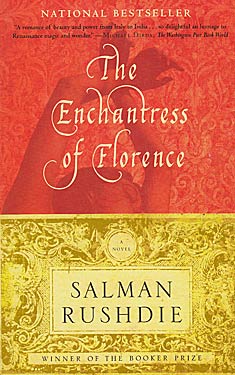 When I thought about authors whom I might read for this blog, Salman Rushdie never came to my mind. The Enchantress of Florence has been on my to-read stack for a while and I vowed to read it this year, but I never thought that I’d write about it here. A few things occurred in a wonderfully serendipitous way that led me to write this blog. First, my blog about Margaret Atwood’s novels produced an interesting discussion about the label “science fiction” and started me thinking about what that label means.
When I thought about authors whom I might read for this blog, Salman Rushdie never came to my mind. The Enchantress of Florence has been on my to-read stack for a while and I vowed to read it this year, but I never thought that I’d write about it here. A few things occurred in a wonderfully serendipitous way that led me to write this blog. First, my blog about Margaret Atwood’s novels produced an interesting discussion about the label “science fiction” and started me thinking about what that label means.
Second, I recently read an anecdote from Brian Aldiss in which he recounts that he, Arthur C. Clarke, and Kingsley Amis were on a panel to give an award for best science fiction novel. These prestigious panelists chose Salman Rushdie’s first novel Grimus as the winner, but the publisher pulled the book at the last minute because they did not want Rushdie to be pigeonholed as a science fiction writer. Aldiss discusses this in an article, “Why Don’t We Love Science Fiction,” by Bryan Appleyard in The London Sunday Times (Dec. 2, 2007). Aldiss supports the publisher’s actions, saying that if Rushdie had “been labeled a science-fiction writer… nobody would have heard of him again.” I’m not sure that I agree that Rushdie would have been doomed to obscurity, but I keep running across the fact that science fiction writing is not bad writing, but the label is a bad label. Aldiss goes on to discuss the fact that the British embrace fantasy novels as books written for children that it’s okay for adults to read (ex. Tolkien, Pullman, Pratchett, Rowling), while they see science fiction as “adolescent” in the pejorative sense.
This claim, finally, leads me back to The Enchantress of Florence: it is fantasy, but fantasy written for adults. So, what do we do with it? Call it magic realism to legitimize it? We could, but this novel is different from Rushdie’s other novels that I’ve read and do consider to be magic realism. My main argument against the magic realism category is The Enchantress of Florence contains no hint of a modern setting. From the beginning, it immerses the reader in a world that is a magical past and stays there. Do I think that it belongs on the F&SF shelves on my local bookstore? Maybe, maybe not, but I do think that it is the kind of book that many WWEnders would enjoy but might not immediately pick up. (Rushdie’s The Satanic Verses, his only book in the WWE database, shows only eleven readers.)
Like many of Rushdie’s works, The Enchantress of Florence juxtaposes East and West. Its historical settings are the court of the Mughal Emperor Akbar the Great and the Renaissance Florence of the de Medicis and Machiavelli. These two settings are linked by the arrival of a blond stranger in Akbar’s city of Fatehpur Sikri. This stranger is a Florentine, pretending to be Queen Elizabeth’s ambassador. (How this comes about makes an interesting start to the novel.) Once that disguise is exposed the stranger begins calling himself by the alias the Mogor dell’Amore (the Mughal of Love). Through this persona, he gains access to Akbar. He says that he has come to tell Akbar a story: “All men needed to hear their stories told. He was a man, but if he died without telling the story he would be something less than that, an albino cockroach, a louse” (89). This story concerns Akbar’s great aunt, the sister of his grandfather. Her name was Qara Köz, and she had been erased from Mughal history. As a young girl, she was a pawn in her brother’s political chess game. She and her sister were given as hostages to the enemy. When she made the choice to remain with her captor, rather than returning to her brother’s court with her sister, her brother, Babar, begins a campaign to erase all traces of her from her native culture.
While unknown in her homeland because of this, she becomes famous in other parts of the world because of her beauty. That beauty evokes power over all men who come in contact with her. Her maid servant, known as the Mirror, is only slightly less beautiful than she is. Here is the experience of one admirer:
“the women coming down toward him were more beautiful than beauty itself, so beautiful that they redefined the term, and banished what men had previously thought beautiful into the ranks of dull ordinariness. A fragrance preceded them down the stairs and wrapped itself around his heart.” (258)
Her beauty is her magic, which she uses to make her way through the world from India to Persia to Anatolia to Florence to the New World, always under the protection of powerful men.
The Mogor dell Amore’s recounting of Qara Köz’s story resembles the tale of The Thousand and One Nights. He portions out his story with digressions and necessary back stories to Akbar, and as he does so, he becomes more and more valuable to the emperor. He is not Scheherazade, telling stories to save his life. Instead he tells the story to find his own place in the world; he is a wanderer looking for a home and implicit in the story he tells is the message that the Mughal empire is his home. However, Rushdie does not model the format of the novel on The Thousand and One Nights. It is not a frame story that focuses on each part of the story as a separate story. Instead, Mogor dell Amore’s story is woven into the narrative of Akbar’s world, which is peopled with trusted advisors, rebellious sons, and multiple wives.
 One of these wives, Jodha is particularly interesting, as she sets one of the novel’s themes, man’s search for the “perfect” woman. Jodha is Akbar’s “imaginary wife, dreamed up by Akbar in the way that lonely children dream up imaginary friends, and in spite of the presence of many living, if floating, consorts, the emperor was of the opinion that it was the real queens who were the phantoms and the nonexistent beloved who was real” (27). His other wives, of course, are jealous of Akbar’s phantom favorite, especially since they claim that he built her “by stealing bits of them all” (45). The only woman he wants is a woman who is not. In her well-considered review of the book, Ursula K. Le Guin points out that all the women in the book are “all stock figures, females perceived solely in relation to the male.” While Le Guin is absolutely correct, women’s power in the book comes through the stereotyped arenas of sex or magic; the men are not any better developed and fall into typical roles of mercenary, trickster, king, despot, etc. I believe that this is because Rushdie is trying to tell a fairy story about history and fable and the fine line between them. The Florentine mercenary, Antonino Argalia, is one of my favorite characters. He becomes a Janissary, fighting for Islam’s most powerful leaders and gains so much power that he can command his own mobile community. Among his loyal followers are gigantic Swiss albino brothers–Otho, Botho, Clotho, and D’Artagnan.
One of these wives, Jodha is particularly interesting, as she sets one of the novel’s themes, man’s search for the “perfect” woman. Jodha is Akbar’s “imaginary wife, dreamed up by Akbar in the way that lonely children dream up imaginary friends, and in spite of the presence of many living, if floating, consorts, the emperor was of the opinion that it was the real queens who were the phantoms and the nonexistent beloved who was real” (27). His other wives, of course, are jealous of Akbar’s phantom favorite, especially since they claim that he built her “by stealing bits of them all” (45). The only woman he wants is a woman who is not. In her well-considered review of the book, Ursula K. Le Guin points out that all the women in the book are “all stock figures, females perceived solely in relation to the male.” While Le Guin is absolutely correct, women’s power in the book comes through the stereotyped arenas of sex or magic; the men are not any better developed and fall into typical roles of mercenary, trickster, king, despot, etc. I believe that this is because Rushdie is trying to tell a fairy story about history and fable and the fine line between them. The Florentine mercenary, Antonino Argalia, is one of my favorite characters. He becomes a Janissary, fighting for Islam’s most powerful leaders and gains so much power that he can command his own mobile community. Among his loyal followers are gigantic Swiss albino brothers–Otho, Botho, Clotho, and D’Artagnan.
These names and other little gems demonstrate Rushdie’s humor and style. The sentences are lush and inventive, all the while giving the reader a knowing wink. An example of this occurs when Rushdie describes the ways that the Mogor dell Amore’s story of Qara Köz filters through the citizens of Akbar’s city:
“As the story of the hidden princess began to spread through the noble villas and common gullies of Sikri a languid delirium seized hold of the capital. People began to dream about her all the time, women as well as men, courtiers as well as guttersnipes, sadhus as well as whores…. She even bewitched the queen mother Hamida Bano, who ordinarily had no time for dreams. However, the Qara Köz who visited Hamida Bano’s sleeping hours was a paragon of Muslim devotion and conservative behavior. No alien knight was allowed to sully her purity.” (197)
The Qara Köz who visits Hamida Bano’s sister-in-law, Old Princess Gulbadan, in her dreams, is quite different:
“a free-spirited adventuress whose irreverent, even blasphemous gaiety was a little shocking but entirely delightful… Princess Gulbadan would have envied her if she could, but she was having too much fun living vicariously through her several nights a week.” (197)
If you enjoyed these sentences, you will enjoy The Enchantress of Florence. If you didn’t, you won’t. It’s that simple.
GMRC Review: Helliconia Spring by Brian Aldiss
 Editor’s Note: Rhonda Knight is a frequent contributor to WWEnd through her excellent blog series Automata 101 and her new series Outside the Norm. This is Rhonda’s second featured review for the Grand Master Reading Challenge.
Editor’s Note: Rhonda Knight is a frequent contributor to WWEnd through her excellent blog series Automata 101 and her new series Outside the Norm. This is Rhonda’s second featured review for the Grand Master Reading Challenge.
Brian Aldiss’ Helliconia Spring has been on my reading list for a long time. I was intrigued by the premise: a planet in a binary system whose long year, or the journey around the brighter, further sun, takes about 2600 Earth years. This means that each change of season is the first that the population has ever seen and seems cataclysmic in a world without any records. This book tells the story of the planet Helliconia as it moves from a world of snow, cold and isolation to a world of warmth, growth, and expansion.
In my opinion, the story does not live up to the premise Aldiss presents. The edition of the novel I read was about 430 pages long. I only became interested in the story around page 230, and unfortunately, I never really became interested in any of the characters, who are generally one-dimensional and whose actions often seem random rather than a part of any greater motivation.
Besides the “human” civilizations on the planet, there are the phagors and Earth humans who observe the planet from above on space station Avernus. He creates the phagors as mankind’s enemy. The phagors are an intelligent type of biped, who evolved separately from the humans. Their society consists of nomadic “herds” that ride on their own domesticated animals. The people on the planet are under continual threat from them. The Earth humans are only watchers. Their observations are beamed to Earth where the activities of Helliconia have become a type of reality show. Earth’s residents, one thousand years in Helliconia’s future, attend public theaters to watch. During the first two-thirds of the book (when the readers are not told about the broadcast function of the space station), the Avernus parts seem disruptive. Only at the end do these Avernus sections add anything to the story. However, Aldiss does not explore the interesting implications that come with the Avernians’ knowledge nor the impact of this reality television back on Earth.
As I read, I starting giving Aldiss the same advice that I give my students when they write academic papers: (1) show, don’t tell; (2) don’t be afraid to cut; and (3) develop your ideas. The first ninety pages of the novel could really benefit from this advice. This section is a prologue of Yuli, the founder of the town that Aldiss will feature in the second part of the novel. Yuli’s adventures are often reported rather than shown. And, in at least one of these reports, Aldiss creates a plot hole that was hard for me to overcome. Yuli’s connection to the latter part of the novel is tangential, and I’m not the only reviewer who has wondered if this part was even necessary.
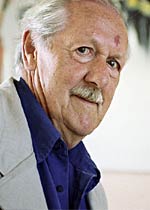 Aldiss’ strength appears in his ideas that demonstrate how the ecology and the economy of the planet awake. He traces the society of Embruddock’s movement from stationary hunter-gatherers to agrarians to a type of medieval village economy, with the development of bridges, mills and money. The moves that he makes using alien flora and fauna are interesting, but I wish that he’d spent more time showing us how these accomplishments come about. However, it is hard to believe that the community of Embruddock can move from hunter-gathers to medieval tradesmen during one lifetime—no matter how fast the world’s ecology is changing. In the end, Aldiss weaves an interesting symbiosis between the microbes, flora, fauna, and the civilizations on the planet. Unfortunately, this intriguing idea about the symbiosis came too late to make me like the book. I wish the whole book had been dedicated to a clear development of that idea.
Aldiss’ strength appears in his ideas that demonstrate how the ecology and the economy of the planet awake. He traces the society of Embruddock’s movement from stationary hunter-gatherers to agrarians to a type of medieval village economy, with the development of bridges, mills and money. The moves that he makes using alien flora and fauna are interesting, but I wish that he’d spent more time showing us how these accomplishments come about. However, it is hard to believe that the community of Embruddock can move from hunter-gathers to medieval tradesmen during one lifetime—no matter how fast the world’s ecology is changing. In the end, Aldiss weaves an interesting symbiosis between the microbes, flora, fauna, and the civilizations on the planet. Unfortunately, this intriguing idea about the symbiosis came too late to make me like the book. I wish the whole book had been dedicated to a clear development of that idea.
Looking at the reading stats in WWEnd, I see that only a few of the members who read Helliconia Spring continued reading Helliconia Summer and Helliconia Winter. Unfortunately, I will be one of those readers who will not finish the series.
Outside the Norm: Ursula K. Le Guin’s Rocannon’s World and City of Illusions
Rhonda Knight is an Associate Professor of English at Coker College in Hartsville, SC. She teaches Medieval and Renaissance literature as well as composition courses. When she looked over last year’s reading list, she was shocked to see that only 17% of the authors she read were women. This blog will record her attempts to read authors that are generally considered out of the science fiction norm: women, persons of color, and non-U.S. and non-U.K. authors.
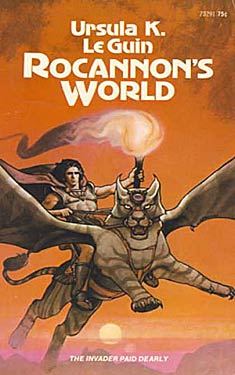 When Rocannon’s World, Planet of Exile and City of Illusions were reprinted in the mid-1970s, Ursula K. Le Guin wrote introductions for each novel. Those introductions contain two passages that tell you everything that you need to know about Rocannon’s World and City of Illusions:
When Rocannon’s World, Planet of Exile and City of Illusions were reprinted in the mid-1970s, Ursula K. Le Guin wrote introductions for each novel. Those introductions contain two passages that tell you everything that you need to know about Rocannon’s World and City of Illusions:
Most of my stories are excuses for a journey. (We shall henceforth respectfully refer to this as the Quest Theme.) I never did care much about plots, all I want is to go from A to B—or, more often, from A to A—by the most difficult and circuitous route. (“Introduction to City of Illusions” in The Language of the Night 147)
And:
But of course fantasy and science fiction are different, just as red and blue are different; they have different frequencies; if you mix them (on paper—I work on paper) you get purple, something else again. Rocannon’s World is definitely purple. (“Introduction to Rocannon’s World” in The Language of the Night 133)
Both novels are about planetary outsiders who must go on a quest. Rocannon, the ethnologist studying Fomalhaut II, is the sole survivor of his expedition group. An unknown alien race blows up his ship and his companions. The destruction of the ship eliminates his mode of communication; therefore, he can’t tell his people that the planet has been attacked. He has no way to protect the indigenous people. Traveling south to the base of the enemy to use their communication equipment to contact his people is his only option. Rocannon assembles a Tolkiensque group, and they begin their quest. The beats of their journey closely resemble Joseph Campbell’s monomyth, outlined in The Hero with a Thousand Faces. There are helpers, threshold guardians, tests, and even a bit of apotheosis. (Another good website about the monomyth is here.)
Falk’s journey in City of Illusions is a quest to learn who he is. The novel opens with Falk’s discovery by an agrarian society. He has no memory, no language. They foster him and teach him their ways, but he is not of their species. He has amber, cat-like eyes that mark him as alien. After living with these people for five years, his instinct tells him that he must journey west toward the legendary city of Es Toch to learn who he is. Unlike Rocannon, he usually travels alone, but like Rocannon, he encounters tests, helpers and threshold guardians along the way.
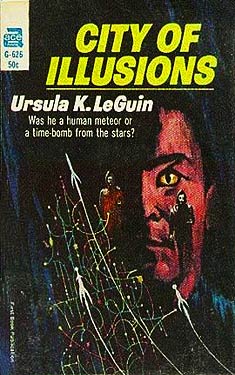 I enjoyed the “purpleness” of both novels as they placed the quest myth on unknown, or at least immediately unrecognizable, planets, whose cultures would be at home in high fantasy. In Rocannon’s World, Le Guin enlivens Norse myth with a slice of Tolkien. The Liuar species who travel with Rocannon has two classes: the Olgyior, who are the servants, and the Angyar, who are the lords. They live within a “feudal-heroic culture,” which Le Guin sums up this way: “They were a boastful race, the Angyar: vengeful, overweening, obstinate, illiterate, and lacking any first-person forms for the verb ‘to be unable.’ There were no gods in their legends, only heroes” (4, 37).
I enjoyed the “purpleness” of both novels as they placed the quest myth on unknown, or at least immediately unrecognizable, planets, whose cultures would be at home in high fantasy. In Rocannon’s World, Le Guin enlivens Norse myth with a slice of Tolkien. The Liuar species who travel with Rocannon has two classes: the Olgyior, who are the servants, and the Angyar, who are the lords. They live within a “feudal-heroic culture,” which Le Guin sums up this way: “They were a boastful race, the Angyar: vengeful, overweening, obstinate, illiterate, and lacking any first-person forms for the verb ‘to be unable.’ There were no gods in their legends, only heroes” (4, 37).
Also, on the planet are the Gdemiar, who had a dwarfish culture before the Hainish envoys enhanced their culture to an industrial level, and the Fiia, who live an elvish, agrarian lifestyle. The Fian, Kyo, who has lost his whole village, joins the quest, giving the reader an insight into that culture that we don’t with the Gdemiar.
In City of Illusions Falk’s journey across a post-apocalyptic North American continent exposes him to many cultures we would see in fantasy novels. There are extended-family agrarians, hunter-gatherers, Taoist hermits, and isolationists, all of whom have developed rituals that suit their cultural needs. The isolationists are the Bee-Keepers, “[a] strange lot, literate and laser armed, all clothed alike, men and women, in long shifts of yellow wintercloth marked with a brown cross on the breast” (277). 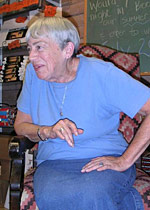 While they treat Falk well, he learns that they capture outside women solely to breed more Bee-Keepers and “worship something called the Dead God, and placate him with sacrifice—murder” (278). Each group Falk encounters serves as either helpers or hinderers on his journey, just as they should in a good quest myth.
While they treat Falk well, he learns that they capture outside women solely to breed more Bee-Keepers and “worship something called the Dead God, and placate him with sacrifice—murder” (278). Each group Falk encounters serves as either helpers or hinderers on his journey, just as they should in a good quest myth.
The characters and ideas expressed in City of Illusions are much more complex than those in Rocannon’s World. Le Guin’s Taoism is much more pronounced as she queries the difference between truth and lies throughout Falk’s journey. The characters and situations are much more gray than the starker black and white of Rocannon’s World. However, I enjoyed reading Rocannon’s World much more. I liked Rocannon more than Falk, perhaps because Falk is a mystery through most of the book. Both books give us a glimpse of the writer that Le Guin will become. We see her world-building, her fascinating cultures, and her wonderful prose.
Outside the Norm: Ursula K. Le Guin’s Planet of Exile
Rhonda Knight is an Associate Professor of English at Coker College in Hartsville, SC. She teaches Medieval and Renaissance literature as well as composition courses. When she looked over last year’s reading list, she was shocked to see that only 17% of the authors she read were women. This blog will record her attempts to read authors that are generally considered out of the science fiction norm: women, persons of color, and non-U.S. and non-U.K. authors.
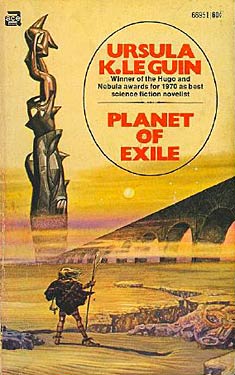 My last blog about Margaret Atwood and science fiction inadvertently led me back to Ursula K. Le Guin, who has been an important commentator on Atwood’s work. (See the comments to that blog to find some interesting links to Le Guin about Atwood and Atwood about Atwood.)
My last blog about Margaret Atwood and science fiction inadvertently led me back to Ursula K. Le Guin, who has been an important commentator on Atwood’s work. (See the comments to that blog to find some interesting links to Le Guin about Atwood and Atwood about Atwood.)
An omnibus edition of Le Guin’s works called Three Hainish Novels has been moving in and out of my to-be-read stack for more years than I’d like to admit. This edition contains the first three Hainish novels, Rocannon’s World (1966), Planet of Exile (1966), and City of Illusions (1967). I don’t know why I’ve not read these novels yet. My favorite book is The Left Hand of Darkness. (I know this because a colleague recently made me choose one book for a list he was putting together. It was very hard to choose, so I decided to pick the book that I had re-read more than any other. That was The Left Hand of Darkness.) When I read it in the late 80s, The Left Hand of Darkness changed the way that I thought about gender, writing, and science fiction. It even spurred me to do a research paper in a linguistics class about pronouns and gender. So, now, almost thirty years later, it’s time to finish the Hainish Cycle, beginning with these three novels. This blog will discuss the middle novel, Planet of Exile.
I like Soft SF, and I like world-building novels. And, lucky for me, so does Le Guin. She writes in her essay "Do-It-Yourself Cosmology":
As soon as you, the writer, have said, "The green sun had already set, but the red one was hanging like a bloated salami above the mountains," you had better have a pretty fair idea in your head concerning the type and size of green suns and red suns—especially green ones, which are not the commonest sort—and the arguments concerning the existence of planets in a binary system, and the probable effects of a double primary on orbit, tides, season, and biological rhythms; and then of course the mass of your planet and the nature of its atmosphere will tell you a good deal about the height and shape of those mountains, and so on, and on…. None of this background work may actually get into the story. But if you are ignorant of these multiple implications of your pretty red and green suns, you’ll make ugly errors, which every fourteen-year-old reading your story will wince at; and if you’re bored by the labor of figuring them out then surely you shouldn’t be writing science fiction. (The Language of the Night, 122)
This kind of specificity and willingness to play with the implications of physical systems allow Le Guin to create intriguing societies that relate to the attributes of the planet. For example, the properties of Werel, featured in Planet of Exile, will create very resilient cultures that are governed by seasonal rhythms:
The green third planet took sixty of Earth’s year’s to complete it year…. The winters of the northern hemisphere, tilted by the angle of the ecliptic away from the sun, were cold, dark, terrible: the vast summers, half a lifetime long, were measurelessly opulent. Giant tides of the planet’s deep seas obeyed a giant moon that took four hundred days to wax and wane. (City of Illusions 307)
Planet of Exile opens as this long, bitter winter comes, and one of the indigenous populations, the Tevarans, begins building its Winter City, a place where this agrarian culture will hunker down to outlast the raging winter and the raids of the nomadic culture, the Gaals, who always move south in winter. This hibernation of approximately fifteen Earth years is something the culture dreads and works to provide for throughout the rest of the long Werel year.
The fertility of the Tevarans is governed by the rhythm of the seasons. One is either Autumn-born or Spring-born. Rolery, a child born in the Summer, is out of sync with her people. Her Father, Wold, considers her place in this polygamous culture:
She looked to be about twenty moonphases old, which meant she was the one born out of season, right in the middle of the Summer Fallow when children were not born. The sons of Spring would by now be twice or three times her age, married, remarried, prolific; the Fall-born were all children yet. But some Spring-born fellow would take her for third or fourth wife; there was no need for her to complain. (Planet of Exile 150)
However, Rolery explains her situation differently:
[W]hen Winter’s over I’ll be too old to bear a Spring child. I’ll never have a son. Some old man will take me for a fifth wife one of these days, but the Winter Fallow has begun, and come Spring I’ll be old…. So I will die barren. It’s better for a woman not to be born at all than to be born out of season as I was. (Planet of Exile 150)
Rolery’s situation makes her an outsider in her own culture. She does not have an age cohort. Her loneliness fuels her curiosity about the other cultures that inhabit the planet. The book opens with Rolery brazenly entering the city of the farborns, the Alterran colonists who arrived six hundred years earlier and had lost contact with their empire, the League of All Worlds. Rolery wants to see the sea, so she travels through the Alterran city. She is almost caught by the fast moving tide, but is saved when the Alterran, Jakob Agat "bespeaks" her—he sends her a telepathic message to run.
 This encounter begins a relationship between Rolery and Jakob. Her situation as a Summer-born allows her to pursue this semi-taboo relationship. (Her father once had a farborn wife, but, of course, Wold is the tribe leader and a man.) Sexual relationships between Alterrans and the planet’s indigenous populations are sterile, but Rolery knows that she is doomed to barren relationships. Therefore, she chooses to become the first wife in a monogamous marriage rather than a later wife in a polygamous marriage.
This encounter begins a relationship between Rolery and Jakob. Her situation as a Summer-born allows her to pursue this semi-taboo relationship. (Her father once had a farborn wife, but, of course, Wold is the tribe leader and a man.) Sexual relationships between Alterrans and the planet’s indigenous populations are sterile, but Rolery knows that she is doomed to barren relationships. Therefore, she chooses to become the first wife in a monogamous marriage rather than a later wife in a polygamous marriage.
This "star-crossed lovers" plot is only a sub-plot in the novel. The real marriage happens between the Alterrans and the Tevarans, who must learn to rely on one another. Those pesky Gaals, who in the past had briefly harried the Winter Cities and the Alterran city as each nomadic group journeyed southward, have organized. Under the leadership of a Gaal Ghengis Khan, these hordes are moving southward as a conquering machine, burning cities, and stealing livestock and provisions. They leave death and destruction behind. Alterran scouts report this to Jakob, who must convince Wold and the Tevarans of the danger. His relationship with Rolery damages his credibility, and as a result of the Tevaran’s inaction their Winter City is destroyed by the Gaal. Alterran guerillas are able to save many of the Tevarans and bring them into their city. The long siege begins, and the Alterrans and the Tevarans have to learn how to live together.
The book is a fun and quick read. The romance is not overdone, and the cultures that Le Guin creates are developed and are not simply opposites of each other. Each culture demonstrates some interesting nuances that fit their unique situations. I think this novel is my favorite of the three. More on the other two in my next blog.
GMRC Review: The Ship Who Sang
 Editor’s Note: Rhonda Knight is a frequent contributor to WWEnd through her excellent blog series Automata 101 and her new series Outside the Norm. It’s no surprise to us that Rhonda’s is the first featured review for the Grand Master Reading Challenge.
Editor’s Note: Rhonda Knight is a frequent contributor to WWEnd through her excellent blog series Automata 101 and her new series Outside the Norm. It’s no surprise to us that Rhonda’s is the first featured review for the Grand Master Reading Challenge.
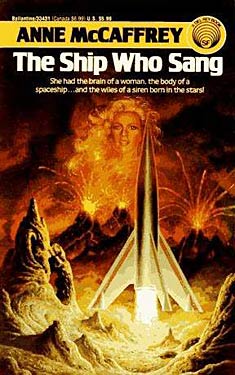 Anne McCaffrey’s The Ship Who Sang is a collection of six novelettes and novellas published between 1961 and 1969. Most of them stand alone but also work well as the continuous story of Helva, the ship who sang. McCaffrey creates a world in which humans have colonized other planets and have discovered many types of life forms “out there.” In this world, however, humans are still born with birth defects. These babies are tested for high levels of brain functions. If they do not pass the tests, they are euthanasized. If they do pass the test, their parents are given the choice between euthanasia or placing them in a school to learn to be the “brains” of a spaceship. These spaceships work for Cencom, delivering important cargo, transporting dignitaries, and other humanitarian or emergency jobs.
Anne McCaffrey’s The Ship Who Sang is a collection of six novelettes and novellas published between 1961 and 1969. Most of them stand alone but also work well as the continuous story of Helva, the ship who sang. McCaffrey creates a world in which humans have colonized other planets and have discovered many types of life forms “out there.” In this world, however, humans are still born with birth defects. These babies are tested for high levels of brain functions. If they do not pass the tests, they are euthanasized. If they do pass the test, their parents are given the choice between euthanasia or placing them in a school to learn to be the “brains” of a spaceship. These spaceships work for Cencom, delivering important cargo, transporting dignitaries, and other humanitarian or emergency jobs.
These babies are taken from their parents and entered into a school, where they are placed into smaller machine bodies and trained for their ultimate insertion into a ship. The children are given drugs to stunt their growth so that they may be permanently fitted into the control column of the ship. For Helva, the ship’s mobility is her mobility; its sensors are her senses. Her body is pumped nutrients, and she never sleeps. McCaffrey’s cyborg ship idea is fascinating, and she explores its potential in the first chapter. Readers learn more about Helva’s existence in the successive chapters.
The class of ship that Helva becomes is called a BB ship, signaling the two components, the brains, Helva and her ilk, and the brawns, the fully mobile human pilots who travel with the ships. The chapters explore Helva’s relationships with her brawns as she and they undertake the assignments given to them by Cencom. In my opinion, the first three chapters are the strongest narratives, both in their relation to one another and as independent stories.
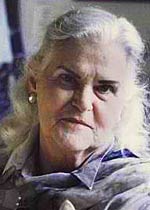 Reading this collection more than forty years after the individual parts were written, I can see how McCaffrey is working with early feminist ideas. Helva is strong, opinionated, and smarter than all of the men she encounters. She is able to choose her brawns, who must court her (McCaffrey’s term). She becomes financially independent in the course of the book, fights for her rights, makes choices that will ensure her growth and well-being. However, the weakness is that McCaffrey can’t quite break out of the idea that the brain-brawn relationship is a traditional concept of marriage. We see Helva fall in love with, break up with and enter into an “oil and water” relationship with various brawns. McCaffrey does not exactly force compulsory heterosexuality on Helva because she once has a female brawn (whom she often misses when the men seem incompatible to her).
Reading this collection more than forty years after the individual parts were written, I can see how McCaffrey is working with early feminist ideas. Helva is strong, opinionated, and smarter than all of the men she encounters. She is able to choose her brawns, who must court her (McCaffrey’s term). She becomes financially independent in the course of the book, fights for her rights, makes choices that will ensure her growth and well-being. However, the weakness is that McCaffrey can’t quite break out of the idea that the brain-brawn relationship is a traditional concept of marriage. We see Helva fall in love with, break up with and enter into an “oil and water” relationship with various brawns. McCaffrey does not exactly force compulsory heterosexuality on Helva because she once has a female brawn (whom she often misses when the men seem incompatible to her).
I applaud McCaffrey for what she was trying to do, but from my future perspective The Ship Who Sang is dated in the way it handles (and focuses on) relationships. I would like to see Helva using her brains to solve problems related to her assignments rather than worrying about her relationships with past, present, and future brawns. However, Helva is a fantastic feminist character and offers strong evidence against the critics who say that science fiction authors can’t create characters with depth.
Outside the Norm: Margaret Atwood’s The Blind Assassin and Oryx and Crake
Rhonda Knight is an Associate Professor of English at Coker College in Hartsville, SC. She teaches Medieval and Renaissance literature as well as composition courses. When she looked over last year’s reading list, she was shocked to see that only 17% of the authors she read were women. This blog will record her attempts to read authors that are generally considered out of the science fiction norm: women, persons of color, and non-U.S. and non-U.K. authors.
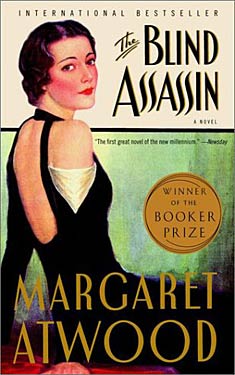 Margaret Atwood has famously denied that she writes “science fiction,” claiming instead that she writes “speculative fiction,” a claim that always sounds less condescending coming from Harlan Ellison than it does from Atwood. This is probably because Ellison knows what he’s trying to define, and Atwood is trying to craft a definition that excludes her own writing from science fiction. According to Atwood, science fiction “is when you have chemicals and rockets” or “monsters and spaceships” or “talking squids in outer space.” For analyses of Atwood’s definitions, see Peter Watts, “Margaret Atwood and the Hierarchy of Contempt” and David Langford, “Bits and Pieces.”
Margaret Atwood has famously denied that she writes “science fiction,” claiming instead that she writes “speculative fiction,” a claim that always sounds less condescending coming from Harlan Ellison than it does from Atwood. This is probably because Ellison knows what he’s trying to define, and Atwood is trying to craft a definition that excludes her own writing from science fiction. According to Atwood, science fiction “is when you have chemicals and rockets” or “monsters and spaceships” or “talking squids in outer space.” For analyses of Atwood’s definitions, see Peter Watts, “Margaret Atwood and the Hierarchy of Contempt” and David Langford, “Bits and Pieces.”
My recent reading of two Atwood novels shows me that she can write science fiction badly and that she can write science fiction well. To be fair, I believe that she was trying to write bad science fiction in The Blind Assassin (2000). This winner of the Booker Prize is a multi-layered novel in which octogenarian Iris Chase Griffen recounts the life of her sister Laura Chase, the author of The Blind Assassin. This fictional book-within-a-book was published after Laura’s untimely death and gained a cult following. The sections of Atwood’s book alternate between Iris writing the story of the Chase girls’ youth and Laura’s novel. The plot of this internal novel is simple: in the 1930s and 40s a married upper-class woman has a clandestine affair with a lower-class man who is on the run. Both these characters are unnamed. He is most likely an active communist who is being pursued by the authorities. He makes his living by writing for science fiction pulp magazines. Most of these chapters follow the formula of the woman visiting the man at his current hideout where their post-coital pillow talk consists of the man entertaining her with science fiction stories he makes up on the spot. Their first foray into storytelling begins like this:
What will it be, then? he says. Dinner jackets and romance, or shipwrecks on a barren coast? You have your pick: jungles, tropical islands, mountains. Or another dimension of space—that’s what I’m best at.
Another dimension of space? Oh really!
Don’t scoff, it’s a useful address. Anything you like can happen there. Spaceships and skin-tight uniforms, ray guns, Martians with the bodies of giant squids, that sort of thing. (9)
It is significant that the character’s list mirrors the entities that Atwood herself references in interviews as I have shown above. Clearly, Atwood, as the writer of The Blind Assassin, and the male writer have a very low opinion of science fiction and its abilities to develop character or plot. For him, science fiction is about an Other (completely undeveloped) and cheap thrills, as their negotiations show:
Then you could have a pack of nude women who’ve been dead for three thousand years, with lithe, curvaceous figures, ruby-red lips, azure hair in a foam of tumbled curls, and eyes like snake-filled pits. But I don’t think I could fob those off on you. Lurid isn’t your style.
You never know I might like them.
I doubt it. They’re for the huddled masses. Popular on the covers though—they’ll writhe all over a fellow, they have to be beaten off with rifle butts.
Could I have another dimension of space, and also the tombs and the dead women, please?
That’s a tall order, but I’ll see with I can do. I could throw in some sacrificial virgins as well, with metal breastplates, and silver ankle chains and diaphanous vestments. And a pack of ravening wolves, extra. (9)
This negotiation ends with him beginning his story of the planet Zycron, which contains some of the ideas he discusses above. The story has too many plot details, many of them never expanded nor explored. While not all of his story ideas are completely cliché in execution, these two pieces of dialog demonstrate how Atwood pigeonholes science fiction.
Unfortunately for Atwood, the story of the lovers and their pulp pursuits are much more interesting than Iris’ main narrative which grows tedious after a while. Also, I figured out the ending surprises with more than 200 pages left which did not increase my interest in the stories Iris tells in either the past or the present. Also, I had trouble reconciling the characters of Iris in the past with Iris in the present.
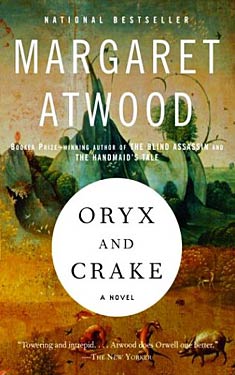 Oryx and Crake (2003) shows that Atwood can write good science fiction; however, she would call it speculative fiction, or writing “based on rigorously-researched science, extrapolating real technological and social trends into the future” (Watts 2). And I thought that was what science fiction was. Atwood creates an interesting post-apocalyptic world in which there is one human survivor who calls himself Snowman. Snowman is the caretaker of a race of bio-engineered humanoids, who were created by his friend Crake. According to Crake, all aggression, greed, and competition have been eliminated in this race. They have an advanced life cycle, becoming “adults” after only a few years. They live a pre-lapsarian lifestyle and eat roots, fruits, and grass. Snowman serves as kind of prophet for them. He teaches them about the flotsam they discover from the previous civilization, telling them if it is useful or dangerous.
Oryx and Crake (2003) shows that Atwood can write good science fiction; however, she would call it speculative fiction, or writing “based on rigorously-researched science, extrapolating real technological and social trends into the future” (Watts 2). And I thought that was what science fiction was. Atwood creates an interesting post-apocalyptic world in which there is one human survivor who calls himself Snowman. Snowman is the caretaker of a race of bio-engineered humanoids, who were created by his friend Crake. According to Crake, all aggression, greed, and competition have been eliminated in this race. They have an advanced life cycle, becoming “adults” after only a few years. They live a pre-lapsarian lifestyle and eat roots, fruits, and grass. Snowman serves as kind of prophet for them. He teaches them about the flotsam they discover from the previous civilization, telling them if it is useful or dangerous.
Before he became the prophet of the Crakers (as he calls them), Snowman was Jimmy, who grew up in an enclosed corporate compound called OrganInc Farms. His father was a prominent bio-engineer working on the Pigoon Project, which created pigs that would grow “an assortment of foolproof human-tissue organs” for transplanting into humans (22). These compounds were mostly self-contained with malls, schools, hospitals, etc. that served the needs of the employees and their families. The compounds are connected by tube trains. The areas in between are called pleebland (read pleeb-land), where the mass of humanity lives: economically disadvantaged, diseased, and the ultimate consumers for the products and techniques created in the compounds. This sociological layout reminds me very much of the world Marge Piercy creates in He, She and It, except that Piercy’s economy is based on computer technology and virtual reality instead of bio-engineering.
Snowman’s narrative covers just a few days in his present as he tries to survive in this devastated landscape where food is scarce and new predators, which were former science projects housed in labs, roam. There are snats (a cross between snakes and rats) and wolvogs (a cross between a dog and a wolf). Also, the pigoons have become carnivores and are getting smarter. The bulk of the past story is about Jimmy, how he came to be a survivor, his love for Oryx, and his friend Crake’s ambition to create better human beings. The end of the book finally shows the readers how the rest of humanity met its demise and the roles that Jimmy, Oryx and Crake played in that disaster.
This book was very enjoyable. The science seems science-y enough, and her portrayal of “reality” broadcasts over the internet, where one could find the Noodie News, open heart surgeries, live coverage of executions, and, of course, enough pornography to cover any viewer’s choices or fetishes, seems especially prescient. The plot is well-paced, and both the present and past events are interesting, so I never found myself wishing I could move on to the next time period, like I did with The Blind Assassin. While I cannot say that I liked The Blind Assassin as much as I liked Oryx and Crake, Atwood writes beautifully and is a pleasure to read. I plan to read The Year of the Flood and The Handmaid’s Talec later this year for this blog.
Automata 101: The Artist as Golem Maker – Part Two
Rhonda Knight is an Associate Professor of English at Coker College in Hartsville, SC. She teaches Medieval and Renaissance literature as well as composition courses. This blog will outline her experiences teaching an Honors English Composition course about created entities, beginning with the golem of Jewish legend and continuing through cyborgs, robots, androids, and artificial intelligence.
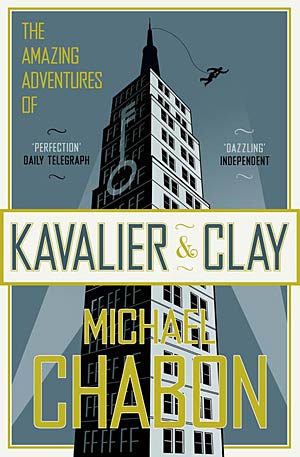 “They’re all Jewish, superheroes. Superman, you don’t think he’s Jewish? Coming over from the old country, changing his name like that. Clark Kent, only a Jew would pick a name like that for himself.” (The Amazing Adventures of Kavalier and Clay, 585).
“They’re all Jewish, superheroes. Superman, you don’t think he’s Jewish? Coming over from the old country, changing his name like that. Clark Kent, only a Jew would pick a name like that for himself.” (The Amazing Adventures of Kavalier and Clay, 585).
The students and I concluded our examination of Kavalier and Clay by looking at the role of comics in the book and how they connect to the protagonists and the figure of the golem. One thing that I like about Michael Chabon is his symbolism is often obvious, but it is executed so beautifully that unwrapping it is a joy. The students, of course, missed much of the obvious, so it was fun watching them see the symbolism unfold. For example, the first viable superhero whom Sammy and Joe create is the Escapist, whose alter ego is Tom Mayflower. It was easy for them to see how Joe–who trained in Prague as an escape artist and a magician and who had to escape Czechoslovakia stuffed in a coffin with the Golem of Prague–is a model for the Escapist. However, the fact that Tom Mayflower represents Sammy was a bit harder for them to see. Tom is crippled just as Sammy is. Tom is an orphan, and Sammy had an absent father, a circus strong man. A similar strong man figure, Big Al, serves as Tom’s surrogate father in the comic. Through Tom and the Escapist, Sammy and Joe are able to fight their personal demons (and Hitler) in the pages of the monthly magazines they create. However, Chabon does not want us to forget that their actions create a golem not just a superhero. He ends the chapter of the Tom Mayflower back-story by connecting Tom and his compatriots in their theater lair with their youthful creators, Kavalier and Clay:
The sound of their raised voices carries up through the complicated antique ductwork of the grand old theater, rising up and echoing through the pipes until it emerges through a grate in the sidewalk, where it can be heard clearly by a couple of young men who are walking past, their collars raised against the cold October night, dreaming their elaborate dream, wishing their wish and teasing their golem into life. (134)
From Joe Kavalier’s first attempt at drawing a golem superhero on his first morning in New York to his magnum opus, a 2,256-page, wordless script called The Golem!, Chabon never lets us forget about the connection between the superhuman golem and America’s comic superheroes. The class and I looked back to Piercy again and again to examine Joseph the golem’s role as a superhero protecting the ghetto. We talked about his size, strength, and ability to heal rapidly. Also he was a more strategic thinker than the humans. He could only die through kabalistic magic. This constant comparison back to Joseph helped the students see what Chabon was attempting in his comparison.
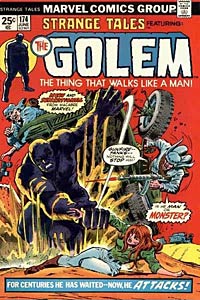 However, through all of this, Chabon wants us to see that we can’t rely on golems any more than we can rely on superheroes. After all, the Jews of Prague don’t activate their golem to fight Hitler. Instead, they send it away in order to protect it. When the box with that same golem mysteriously arrives at Sammy’s home many years after the war, it is nothing but a box of dirt. According to Jewish legend, when it left its homeland, it disintegrated and lost its potency.
However, through all of this, Chabon wants us to see that we can’t rely on golems any more than we can rely on superheroes. After all, the Jews of Prague don’t activate their golem to fight Hitler. Instead, they send it away in order to protect it. When the box with that same golem mysteriously arrives at Sammy’s home many years after the war, it is nothing but a box of dirt. According to Jewish legend, when it left its homeland, it disintegrated and lost its potency.
Chabon’s message is that the modern golem is found in the creation of art. His own piece about golems and novel writing shows this. I ended the class by reading an engaging passage from the book, and I will end this blog in the same way. Here, Joe is thinking about all of the detritus of his life as a comic book artist:
In literature and folklore, the significance and the fascination of golems—from Rabbi Loew’s to Victor von Frankenstein’s—lay in their soullessness, in their tireless inhuman strength, in their metaphorical association with overweening human ambition, and in the frightening ease with which they passed beyond the control of their horrified and admiring creators. But it seemed to Joe that none of these—Faustian hubris, least of all—were among the true reasons that impelled men, time after time, to hazard the making of golems. The shaping of a golem, to him, was a gesture of hope, offered against hope, in a time of desperation. It was the expression of a yearning that a few magic words and an artful hand might produce something—one poor, dumb, powerful thing—exempt from the crushing strictures, from the ills, cruelties, and inevitable failures of the greater Creations. It was the voicing of a vain wish, when you got down to it, to escape. (582).
Automata 101: The Artist as Golem Maker – Part One
Rhonda Knight is an Associate Professor of English at Coker College in Hartsville, SC. She teaches Medieval and Renaissance literature as well as composition courses. This blog will outline her experiences teaching an Honors English Composition course about created entities, beginning with the golem of Jewish legend and continuing through cyborgs, robots, androids, and artificial intelligence.
Note: I’m not sure why I feel the need to announce spoilers here since I have not done so with my previous blogs, but be warned I give away a lot of plot here.
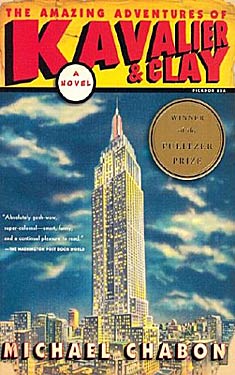 The last book that we read was Michael Chabon’s The Amazing Adventures of Kavalier and Clay. I highly recommend this book. I think it is much more interesting than the Hugo-winning The Yiddish Policeman’s Union, and it has convinced me that I need to read everything that Chabon has written.
The last book that we read was Michael Chabon’s The Amazing Adventures of Kavalier and Clay. I highly recommend this book. I think it is much more interesting than the Hugo-winning The Yiddish Policeman’s Union, and it has convinced me that I need to read everything that Chabon has written.
I put this book last on the syllabus for a couple of reasons. First, it is very long (636 pages), so I wanted to spread the reading out. The students were working on their research papers at the same time, so there were writing and research days interspersed. Second, because the book is recent, I was not sure how much research existed on it, so I placed it late in the semester so that it would not be an obvious choice to be the subject of the research paper. While the students did not like the length of the novel (and had a hard time keeping up with the reading schedule), they did like the book very much. I think that they were appreciative of a non-science fiction book at this point in the semester. One thing that I’ve learned is that habitual readers of speculative fiction grasp an author’s constructed world very quickly and therefore, understand the culture, laws, etc. without much effort. Many of the students, either through age or reading experience, were not facile in their grasp of Dick’s or Piercy’s dystopias. Therefore, Kavalier and Clay gave them a world that they knew something about and operated in much the same way as their own.
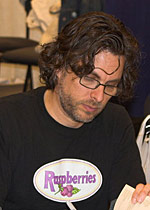 Teacherly confession: I loved Kavalier and Clay when I read it in July, but I had no idea how I was going to teach it or how I was going to tie it into the other texts. I decided I’d figure it out, and luckily I did. I could have never made the book work if I had not taught Piercy’s He, She and It. In Piercy’s novel, Malkah’s interwoven story of Joseph the golem laid the foundation for Chabon’s golem. The students entered the first section with most of the background they needed to understand Josef Kavalier’s escape from Czechoslovakia.
Teacherly confession: I loved Kavalier and Clay when I read it in July, but I had no idea how I was going to teach it or how I was going to tie it into the other texts. I decided I’d figure it out, and luckily I did. I could have never made the book work if I had not taught Piercy’s He, She and It. In Piercy’s novel, Malkah’s interwoven story of Joseph the golem laid the foundation for Chabon’s golem. The students entered the first section with most of the background they needed to understand Josef Kavalier’s escape from Czechoslovakia.
Our discussion opened with a look at the narrative voice. The book is written in the third person, but not in the typical third person omniscient manner. One feels that the narrator is a scholar, historian, biographer or comic book fan, as the book’s first sentences show:
In later years, holding forth to an interviewer or to an audience of aging fans at a comic book convention, Sam Clay liked to declare, apropos of his and Joe Kavalier’s greatest creation, that back when he was a boy, sealed and hog-tied inside the airtight vessel known as Brooklyn, New York, he had been haunted by dreams of Harry Houdini. “To me, Clark Kent in a phone booth and Houdini in a packing crate, they were one and the same thing,” he would learnedly expound at WonderCon or Angloulême or to the editor of The Comics Journal.
In support of this voice, the book contains footnotes (although not to the level of Susanna Clarke’s Jonathan Strange and Mr. Norell) that informs the reader of such things as $42,200 was the selling price of Amazing Midget Radio Comics #1 in 1998 and Roy Lichtenstein might have been inspired by an enlarged comic page framed in Sammy’s office that revealed the lithography dots. I taught the students to look for such textual clues that reveal the humanity of the narrator.
In the second class, I told the students that I wanted to look at the protagonists’ names, Josef Kavalier and Sammy Klayman. We talked about their meanings: Kavalier = Cavalier = Chevalier = Knight; and Klayman = Clay Man = Golem. I admitted to them that I was unsure what to do with those meanings but suggested that we think about how to apply them as we continued to read. We came to the meaning of Joe’s surname quickly. If we took “knight” to mean “knight in shining armor,” then it is easy to apply the cliché and find a hero and a rescuer in Joe. His commitment to his Czech relatives and his actions during WWII are heroic in their own way. In his return after the war, he becomes a superhero, like one of his creations, with a secret lair and a disguise.
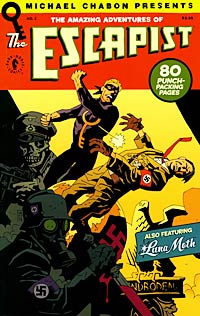 Sammy’s role as the golem was harder to understand. Once we started to think about the golem’s role as a protector of the Jews, we were able to see that Sammy becomes the protector of Joe’s fiancée, Rosa, and her unborn child. Sammy, who was planning on moving to L.A. with his male lover, marries Rosa after Joe runs away and joins the Navy. Instead of protecting the ghetto, Sammy as golem makes a family and moves it to the Long Island suburbs. He suppresses his own sexuality to play the straight family man for Joe. In our discussion of He, She and It, we looked at the callous way that the Rabbi “deactivates” the golem Joseph. We felt that the ambiguity of Kavalier and Clay’s ending indicated Sammy’s deactivation as a golem: his job was done, and he became disposable. I stressed to the students that everything the narrative voice had been telling us about Sammy demonstrated that Sammy had a good life after he left. We decided that his golem, unlike all of the golems we had encountered, received his freedom.
Sammy’s role as the golem was harder to understand. Once we started to think about the golem’s role as a protector of the Jews, we were able to see that Sammy becomes the protector of Joe’s fiancée, Rosa, and her unborn child. Sammy, who was planning on moving to L.A. with his male lover, marries Rosa after Joe runs away and joins the Navy. Instead of protecting the ghetto, Sammy as golem makes a family and moves it to the Long Island suburbs. He suppresses his own sexuality to play the straight family man for Joe. In our discussion of He, She and It, we looked at the callous way that the Rabbi “deactivates” the golem Joseph. We felt that the ambiguity of Kavalier and Clay’s ending indicated Sammy’s deactivation as a golem: his job was done, and he became disposable. I stressed to the students that everything the narrative voice had been telling us about Sammy demonstrated that Sammy had a good life after he left. We decided that his golem, unlike all of the golems we had encountered, received his freedom.
I’ve managed to demonstrate only a portion of our discussion. In my next blog, I will talk more about Chabon’s use of the superhero and its relation to the golem.



















 Full Details
Full Details
